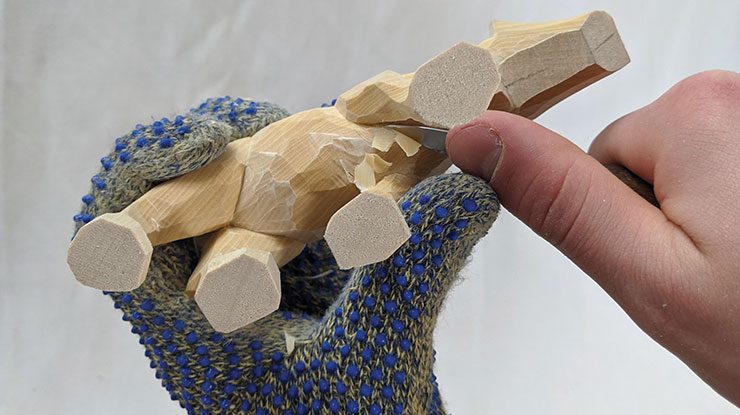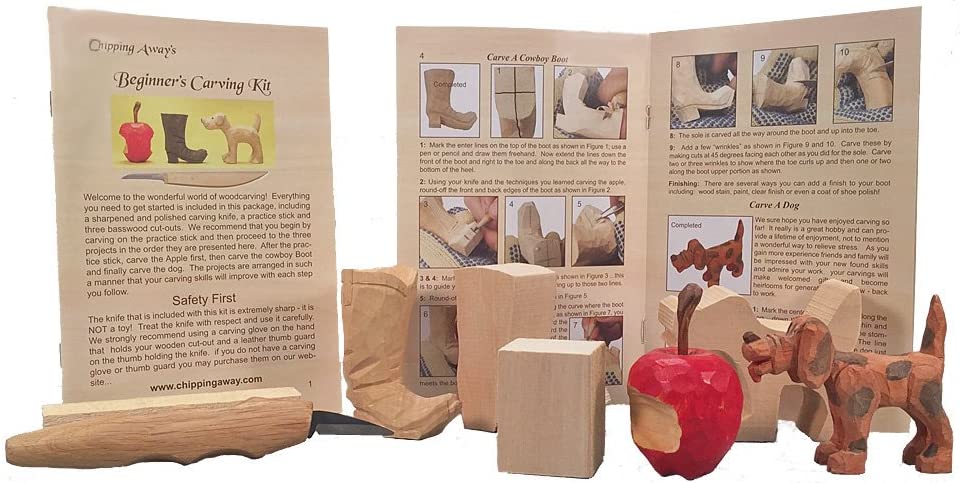
Sharp edges enhance the enjoyment of wood carving. Here are some methods that you can use to sharpen your wooden carving tools. Sharper edges will also last longer than duller ones and are therefore more durable. Sharp edges are more efficient and allow you to use your tools more effectively. Sharp edges simplify carving and increase cutting efficiency. Here are three methods for sharpening wood carving tools. Read on to learn more. - Sharpening a stone.
Sharp edges are a great way to enhance your carving experience
Use razor-sharp tools for the best carving experience. Sharper tools require less effort, and are easier to control during carving. A smooth, well-cut blade gives you a smooth cut. For a successful carving job, sharp tools are vital. You can achieve the best results by regularly sharpening your carving tools. Regular sharpening will keep your carving tools sharp and make it easier.
While carving may be more enjoyable with sharp edges, it can lead to blisters. Wood's natural texture can be rough so regular handling will make the skin more resilient. Blisters will eventually heal into calluses, but this process is time-consuming and often painful. Try changing how you hold your tools if you notice blisters while carving. You may need to practice, but it will pay off in the end.
To sharpen knives, you should first use a sharpening device and a fine grained stone. Make sure to inspect the edge for damage. Chips near the edge require more aggressive grinding. An edge that is dull may need minimal grinding with a finer grinder. The knife can be tested by cutting through some paper or rope. If the knife has been dull for a while, you may not have to use a sharpening stone.
Common techniques to sharpen wood carving tools
There are many ways to sharpen wood carving tools. There are several options for sharpening wood carving tools. Oil stones require oil to be applied on the stone's surface to prevent metal particles from embedding themselves in the surface. For sharpening carbide-wood carving tools, ceramic and diamond stones do not require oil. This article will talk about the common methods of sharpening wooden carving tools.

To remove the wire edge from a knife blade and to polish it, leather strops are useful. While a leather strop is generally good for all tools, some carvers prefer a textured one. A flat leather strop is best for straight tools, or the outside edge gouges. If you're serious about your work, it might be worth investing in a leather strap with grooves.
Bench chisels are traditionally sharpened at a 25-degree angle with a five-degree secondary bevel. Modern alloys may not work well with these angles, and could even crack. Therefore, it is necessary to increase the angle at which the bevel is placed. This requires you to exert more force and will give you less control. Block planes are sharpened at a twenty-degree angle.
Use a sharpening tool
You can sharpen your wood carving tools with a sharpening tool. The stone is made up of grit which is a crystalline mineral that is much harder than steel. It also has sharp edges. A lubricant is required to help the stone cut and prevent metal particles becoming embedded. Once you have sharpened your edge to make it easier to cut wood, it will also be less resistant. The strop, usually made of leather, serves to polish the edge and remove the burr.

There are many types and brands of sharpening tools on the market. There are oilstones that can be used for sharpening, waterstones and ceramic stones. Oil stones use oil for lubrication to prevent metal particles from being buried beneath the stone surface. No lubricants are required for ceramic or diamond stones. They both work well in sharpening the carbide wood carving instruments.
Sentima's sharpening stone is an example of a top-quality system. It comes in two sizes, a coarse one and a fine one. Both are made from corundum. This material features a consistent grain that allows for fast cutting and smooth finishes. Its unique design makes it easy to clean. The sharpening system is made of durable materials and will last for years without degrading in quality.
FAQ
Where can I purchase woodworking supplies
There are many places you can get everything you need, and you don't have to go far. You can visit your local hardware stores, or you can look online at sites like Amazon.com.
You can also search flea and garage sales for furniture and other materials that can be reused.
How often should I buy new supplies?
You will likely need to replace some tools over time. If you're using hand tools, you'll need to sharpen them regularly. For power tools, replacement parts will be required frequently. Try spreading your purchases over a few months so you don't buy too many at once.
Is there a way to start my own woodworking company?
It can be difficult to start your woodworking business. There are many regulations and legal requirements that you will need to comply with. However, it doesn't necessarily mean you must go through all the hassle of setting up a business. Many people decide to join established businesses. This way, you only need to pay membership fees and taxes.
What is the difference in plywood and particleboard?
Plywood is a combination of layers of wood, which are then pressed together under high pressure. Plywood can come in many thicknesses and is used for flooring and cabinets. Particle board can be made from sawdust, resin, and then compressed to make large blocks. It is used primarily for home improvements. Both boards are strong and can be easily cut.
What wooden items do you sell well?
Most wooden items that are best-sellers are made from wood harvested sustainably.
The most used wood types for furniture are oak, maple and walnut.
These woods are strong and durable, with beautiful grain patterns. They are also very durable if properly maintained.
To protect wooden furniture from moisture damage, you should paint it first. This includes all surfaces, including drawers, doors, and handles.
You want your furniture to last as long as possible so you need to choose a paint that is water resistant.
It is recommended to use an oil-based primer, then apply two coats. Depending on the amount of wear, you may need several coats.
Spray cans and aerosol spray paints are not recommended. These products are contaminated with solvents, which evaporate rapidly and can leave behind toxic fumes.
How can I learn basic woodworking skills
It is an excellent way to learn how to build furniture. You can make a simple bench yourself. This project can easily be done using whatever wood you have at your house. You don't need to know which type of wood you should use. Instead, get some pine boards at Lowes or Home Depot. After you've constructed your bench you'll want sand all the rough edges off and varnish it.
Statistics
- Woodworkers on the lower end of that spectrum, the bottom 10% to be exact, make roughly $24,000 a year, while the top 10% makes $108,000. (zippia.com)
- If your lumber isn't as dry as you would like when you purchase it (over 22% in Glen Huey's opinion…probably over 10-15% in my opinion), then it's a good idea to let it acclimate to your workshop for a couple of weeks. (woodandshop.com)
- Overall employment of woodworkers is projected to grow 8 percent from 2020 to 2030, about as fast as the average for all occupations. (bls.gov)
- Most woodworkers agree that lumber moisture needs to be under 10% for building furniture. (woodandshop.com)
External Links
How To
How to stain wood
Staining wood is the process of applying chemicals to the wood's exterior, which alters its color. This chemical reaction causes the wood to change from white to brownish red. Although oak is the most popular type of wood to stain, there are many other types that can be used.
There are many options for applying stains to wood surfaces. Some methods involve mixing the stain with a solvent (such as turpentine) and then brushing or spraying the mixture onto the wood. Other methods use a solution of water and dye applied directly to the wood. You can mix stains into varnishes or paints to make them part of your finish coat.
Preparing the wood surface is the first step to staining it. Cleaning the wood thoroughly removes any dirt or grease that could interfere with applying the stain. Sanding smoothens any scratches or rough spots. The next step is to choose the stain type you want. There are two main types of stain: non-penetrating and penetrating. Penetrating stains penetrate deeper into the wood than non-penetrating ones, making them ideal for dark colors such as mahogany. Non-penetrating oils work best when used with light colors, like maple.
After choosing the type and application method you prefer, gather your tools. Paintbrushes are great for applying stain because they allow you to evenly spread the liquid across the surface. It is a good idea to have rags on hand in case you need them to clean up any stains that may remain after you have finished painting. If you plan on mixing the stain yourself make sure that you have enough containers to hold the different components.
Once you have prepared all your materials, it is time to clean the areas where you will stain the wood. To remove dirt and dust, use warm water and soap. Use a dampened rag and clean water to wipe the furniture. You should remove any debris, especially if your plan is to stain darker wood.
Next, apply the stain. Begin at one end and spray or brush the stain on the wood. Move slowly and carefully along the grain of your wood until you reach its opposite end. Make sure that the stain does not drip off the edge of the wood. Before you proceed with the next steps, let the stain dry completely.
Protect the painted surface with a coat polyurethane paint sealant. Three coats are recommended for polyurethane. Allow the third coat to dry overnight before sanding the final coat.